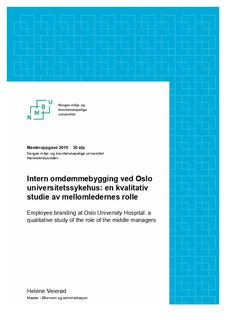| dc.contributor.advisor | Wæraas, Arild | |
| dc.contributor.advisor | Dahle, Dag Yngve | |
| dc.contributor.author | Veierød, Helene | |
| dc.coverage.spatial | Norway, Oslo | nb_NO |
| dc.date.accessioned | 2019-09-03T10:49:04Z | |
| dc.date.available | 2019-09-03T10:49:04Z | |
| dc.date.issued | 2019 | |
| dc.identifier.uri | http://hdl.handle.net/11250/2612234 | |
| dc.description.abstract | Intern omdømmebygging handler om hvordan en organisasjon kan få de ansatte til å bidra til å bygge et godt omdømme for organisasjonen. Det er de ansatte som daglig formidler merkevaren når de er i kontakt med kunder og andre interessenter. Dette medfører at hvordan de ansatte formidler organisasjonens merkevare gjennom sin atferd, sitt utseende og måten de samhandler med kunder og andre interessenter på, er med på å bygge organisasjonens omdømme. For å sikre at de ansatte formidler ønsket merkevare er organisasjoner avhengig av god intern omdømmebygging. Intern omdømmebygging er et forskningsfelt som har fått mer oppmerksomhet de siste årene, men det finnes fortsatt få studier fra offentlig sektor, og helsesektoren spesielt. Jeg har derfor studert intern omdømmebygging ved Oslo universitetssykehus (OUS).
Formålet med oppgaven er å undersøke i hvilken grad og på hvilken måte mellomlederne ved OUS er involvert i den interne omdømmebyggingen, og hvilken påvirkning mellomledernes involvering har på de ansatte og deres ytringsrom. Dette har jeg studert ved bruk av kvalitativ metode. Jeg har gjennomført semistrukturerte dybdeintervjuer av mellomledere og ansatte, samt gjennomført dokumentanalyse.
Resultatene viser at mellomlederne ved OUS spiller en viktig rolle i den interne omdømmebyggingen. Ved bruk av teknokratisk kontroll gir mellomlederne direkte føringer for hvordan de ansatte skal formidle den ønskede merkevaren, samtidig som de gjennom normativ kontroll klarer å indirekte kontrollere de ansattes identitet og atferd. Funnene viser at de ansatte dermed klarer å internalisere organisasjonens merkevare og verdier, og oppnår å bli merkevareambassadører. OUS har flere interne kommunikasjonsarenaer som de ansatte kan bruke til å dele sine meninger, og hvor de føler at de blir hørt av mellomlederne. Dette bidrar til å redusere risikoen for negativ omtale i eksterne ytringsrom. Resultatene viser at det finnes klare restriksjoner for de ansattes ytringer i eksterne rom, både av teknokratisk og normativ karakter. Mellomlederne spiller en viktig rolle i formidlingen av dette. | nb_NO |
| dc.description.abstract | Employee branding is about how an organization can make the employees contribute to building a good reputation for the organization. The employees communicate daily the brand when they are in contact with customers and other stakeholders. As a result, how the employees convey the organization’s brand image through their behaviour, appearance and the way they interact with customers and other stakeholders helps build the organization’s reputation. To ensure that the employees convey the desired brand image, organizations are dependent on successful employee branding. Employee branding is a research field that has received more attention in recent years, but there are still few studies from the public sector, especially in the health sector. Thus, I have studied employee branding at Oslo University Hospital (OUS).
The purpose of this thesis is to study to what extent and in what way the middle managers at OUS are involved in the employee branding, and what kind of influence the middle managers have on the employees and their employee voice. A qualitative method was used. I conducted semi-structured in-depth interviews with middle managers and employees, and also performed document analysis.
The results show that the middle managers at OUS play an important role in employee branding. By using technocratic control, the middle managers give direct guidance on how the employees should convey the desired brand image, while at the same time, using normative control to indirectly control the employees´ identity and behaviour. Consequently, the employees were able to internalize the organization’s brand image and values, and succeeded in becoming brand ambassadors. OUS has several internal communication arenas that employees can use to share their opinions and where they feel heard by the middle managers. This reduces the risk of negative external communication. The results also show that there are clear restrictions on the employee voice regarding external communication, both through technocratic and normative control. The middle managers play an important role in the implementation. | nb_NO |
| dc.language.iso | nob | nb_NO |
| dc.publisher | Norwegian University of Life Sciences, Ås | nb_NO |
| dc.rights | Attribution-NonCommercial-NoDerivatives 4.0 Internasjonal | * |
| dc.rights.uri | http://creativecommons.org/licenses/by-nc-nd/4.0/deed.no | * |
| dc.title | Intern omdømmebygging ved Oslo universitetssykehus : en kvalitativ studie av mellomledernes rolle | nb_NO |
| dc.title.alternative | Employee branding at Oslo University Hospital : a qualitative study of the role of the middle managers | nb_NO |
| dc.type | Master thesis | nb_NO |
| dc.subject.nsi | VDP::Samfunnsvitenskap: 200::Økonomi: 210 | nb_NO |
| dc.description.localcode | M-ØA | nb_NO |

